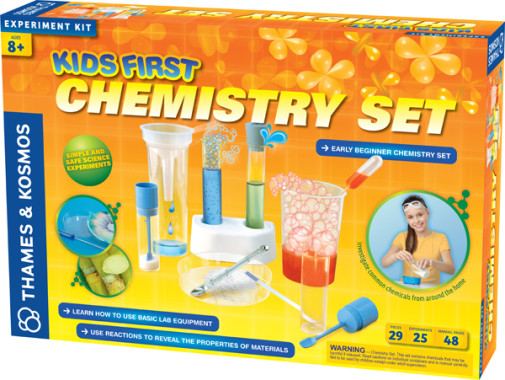We use cookies to make your experience better. To comply with the new e-Privacy directive, we need to ask for your consent to set the cookies. Learn more.
Chemistry Set (Kids First Level 3)
You may be tempted to bypass this exceptional chemistry kit in light of the unassuming title of "first chemistry set." There is nothing babyish or fluffy about this kit. Rather, this kit introduces rock-solid chemistry to the upper elementary and middle school student. Suffice it to say, these are not childish or overly simplistic experiments. Beginning with making a plaster test tube stand, the twenty-five experiments that follow cover a wide range of concepts. Examples include dissolving salt and sugar solutions, evaporation, making crystals, acid and alkalis, and so much more. Contained within the sturdy cardboard kit are the required lab equipment and an Experiment Manual. I think you will be pleasantly surprised at the vibrant illustrations in this 8 ½" x 11 ½", 48 pg. manual. Not only is it appealing to look at, valuable content includes teaching tips, the ABC's of experimentation, basic rules of safety for the science lab, a master material list and specific experiment lists, step by step instructions for labs, explanations of chemical reactions and other interesting tidbits related to various experiments. Included science tools included: plaster, measuring spoon, 100 and 200 ml. measuring cups, label sheets, plaster mold, rubber stopper, pH step strips, magnifying lens, Petri dish with lid, pipettes, test tubes, filter paper, vial with spoon, funnel, balloon, bendable drinking straw, safety glasses, and wooden spatula. You will need to supply a variety of readily available items (contact us for a full list). Parental Supervision required. ~Deanne
Kick off a chain reaction of fun-filled experiments with this introductory chemistry set designed specifically for young kids. Junior chemists can safely explore simple chemistry using the tools in this kit and common household substances from the kitchen, bathroom, and laundry room. Learn how to use basic chemistry equipment such as filters, test tubes, pipettes, and measuring spoons, and beakers. Make your own test tube racks out of plaster and learn about the chemical reaction that formed them. Conduct experiments to identify different chemicals using reactions, heat, evaporation, and crystallization. Examine the composition of inks and dyes with chromatography experiments, where colors magically separate from one another on a filter paper disk. Explore the properties of water, soaps, and oils. Experiment with acids and bases using indicators (pH strips and cabbage juice) to identify them. Make fizzy reactions with acids and bases to dissolve shells and inflate balloons. Discover the invisible gas carbon dioxide and its very visible effects. The full-color, 48-page manual guides inquisitive young chemists and their adult supervisors through safely conducting each of the 25 experiments.
This great new series is for your youngest engineers and scientists. Level 1 is for ages 3 to 5, and level 2 is for 5 to 7. This is a brand new line for Thames and Kosmos and is intended to introduce young learners to science and math concepts while also developing fine motor skills and visual/spatial reasoning. At level 1, the building is accompanied by an engaging storybook (24 pages in length), pretend play, and simple activities. The activities reflect the content of the story line and use chunkier building pieces that are great for smaller hands. Each kit comes nicely packaged in a durable storage container.
Level 2 takes children to the next level of science there are no storybooks, but a detailed 48-page, illustrated guide book comes in every kit. These kits introduce children to the scientific method and teach science basics using hands-on experiments. Level 2 kits do not have a storage container.
| Product Format: | Other |
|---|---|
| Brand: | Thames and Kosmos |
| Grades: | 2-AD |
| EAN/UPC: | 814743010611 |
| Length in Inches: | 11.5 |
| Width in Inches: | 16.5 |
| Height in Inches: | 3.5 |
| Weight in Pounds: | 2.6 |

